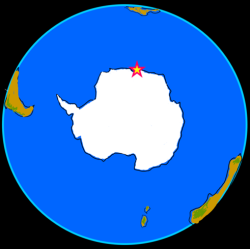2023.03.27
News
【Department of Biological Sciences】 Discovering the mechanism of photosynthesis of an Antarctic alga by infrared light

Colonies of Prasiola crispa formed on rocks around Showa Station in Antarctica (☆ mark on the right earth map). Photo taken during the summer time by the 54th Antarctic Research expedition. The 23cm ruler is placed next to them for comparison. (credit: Astrobiology center)
The research group led by Makiko Kosugi, Joint Researcher at the Department of Biological Sciences, (Project Researcher at Astrobiology Center and Specially Appointed Assistant Professor at National Institute for Basic Biology) and Hiroyuki Koike, Professor at the Department of Biological Sciences, Faculty of Science and Engineering and others identified the light-harvesting antenna protein complex (Pc-frLHC) which involves in photosynthesis of an Antarctic green alga (Prasiola crispa), and resolved its structure by cryogenic electron microscopy (cryo-EM). They have clarified the mechanism by which P. crispa can perform photosynthesis using infrared light, which ordinary plants and algae cannot use. The achievement of this research is published in Nature communications (February 15th, 2023)

※ここでお届けしている記事は、PDF形式のファイルです。PDFファイルは、Adobe社が無料配布するソフト「Adobe Reader」のご利用により、印刷物をほぼそのままのかたちでご覧いただけ、プリンターで印刷することもできます。
PDFファイルをご覧いただくにはAdobe Readerが必要です。お持ちでない方はAdobe社のサイトよりダウンロードのうえご利用ください。
